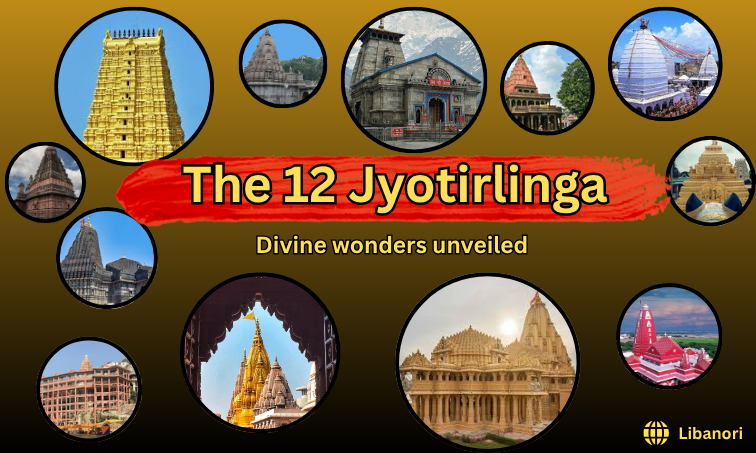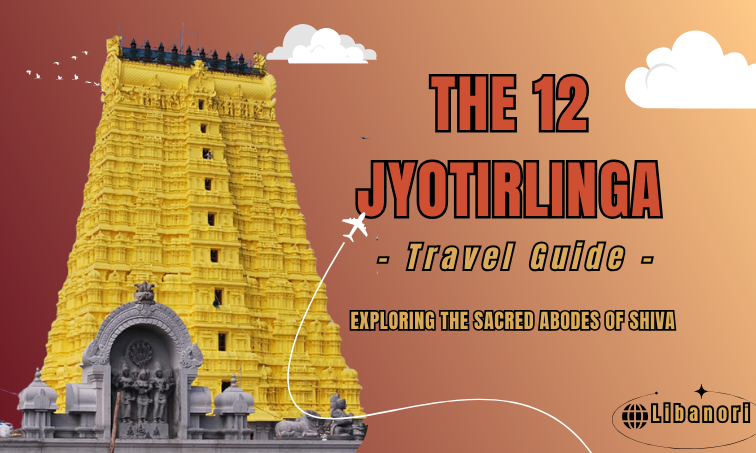The most sacred and worshipped abodes of lord Shiva are the 12 Jyotirlings. Each representing a distinct manifestation of the deity. The temples are scattered across a vast vista in the north Indian region. These pilgrim hotspots attract millions of devotees every year, to make it to these holy shrines, devotees navigate through tough terrains, which are comprised of mountains and forests.
According to ancient Hindu scriptures, a Jyotirling symbolizes the eternal and boundless form of Shiva. If you seek spiritual solace or love exploring new destinations, then this pilgrimage is for you. It is believed that each shrine is related with a different legend. Let’s dive into the history and mystic weight surrounding the 12 Jyotirlinga.
What Are Jyotirlingas?
Let’s start with the fundamentals. ‘Jyoti’ and ‘Linga’ are the two sankrit words from which the term Jyotirlinga is derived from. According to Hindu mythology, these are the sacred sites where Shiva manifested as a column of divine light, representing his infinite essence.
The story goes that Brahma and Vishnu disagreed over who was the supreme deity. To resolve this dispute, Shiva appeared as a towering pillar of light and challenged them to discover its beginning or end. Both deities were unable to do so, demonstrating Shiva’s limitless power. The locations where his light graced the earth became the revered Jyotirlingas.
| Jyotirlinga | Location |
| Somnath | Prabhas Patan, Gujarat |
| Mallikarjuna | Srisailam, Andhra Pradesh |
| Mahakaleshwar | Ujjain, MP |
| Omkareshwar | Mandhata Island, MP |
| Baidyanath | Deoghar, Jharkhand |
| Bhimashankar | Pune, Maharashtra |
| Rameshwar | Rameswaram, Tamil Nadu |
| Nageshwar | Dwarka, Gujarat |
| Vishwanath | Varanasi, UP |
| Trimbakeshwar | Nashik, Maharashtra |
| Kedarnath | Kedarnath, Uttarakhand |
| Grishneshwar | Ellora, Maharashtra |
Journey Through the 12 Jyotirlinga
Let’s explore each temple one by one:
Somnath
Often called the “Eternal Shrine,” this place is a mark of both resilience as well as also for faith. Ruined and reconstructed many times over many believe that the Moon God built this temple himself.
Mallikarjuna
It is considered a sacred place as well asa Jyotirlinga. This temple is revered as a Shakti Peeth. Shiva and Parvati allegedly live here together to give pilgrims power and peace.
Mahakaleshwar
The amazing Bhasma Aarti worships the deity through sacred ash at dawn and for its lingam facing south uniquely.
Omkareshwar
A serene spot combining natural beauty as well as spiritual energy, is set on an island within the Narmada River shaped as the sacred ‘Om’ symbol.
Baba Baidyanath Dham
The shrine is also known as Baidyanath. The temple is believed to its healing powers within. Legend states Ravana sacrificed his ten heads here.
Bhimashankar
The temple’s location is indeed a haven for trekkers as well as also nature lovers. The River Bhima has its origins within that location too.
Rameshwar
The Ramayana relates to this temple in a close way. Lord Rama did worship Shiva at this place, to absolve himself after he defeated Ravana.
Nageshwar
Nageshwar gives protection for one from each of the forms of poison and from evil too. The towering statue of Shiva is situated here.
Vishwanath
Kashi Vishwanath, is situated inside Varanasi. It is believed that a visit to this place is supposed to give liberation (moksha).
Trimbakeshwar
The shrine is near Nashik, stands apart just for its three-faced linga since it shows Brahma, Vishnu, and Shiva. It’s also the origin of the holy Godavari River.
Kedarnath
High up in the Himalayas, Kedarnath is both a Jyotirlinga and part of the Char Dham pilgrimage. The trek is difficult but rewarding.
Grishneshwar
The smallest of the Jyotirlingas, Grishneshwar, is located near the UNESCO World Heritage Ellora Caves. Its peaceful setting makes it a favorite among pilgrims.
Spiritual and Cultural Significance
Amongst many revered Shiva temples like Kalpeshwar, Tungnath and Rudranath. What exactly makes the 12 Jyotirlings so different? For believers, visiting all the Jyotirlingas is synonymous with moving a step further on the path of liberation. Together, they represent the infinite nature of Lord Shiva. Symbolic festivals like Maha Shivratri attract thousands of pilgrims to these temples. The ritual, architecture, and local legends make visiting these places an extremely enriching experience. The 12 Jyotirlinga not only has religious depth, but it also holds deep cultural and historical weight.
Conclusion
The 12 Jyotirlingas are more than just temples; they are gateways to the mystical soul of India. Each sanctum tells a story of the timeless power of devotion. Whether you choose to visit one or go for all, the journey will transform you by experiencing the energy of these temples, and you will make impactful memories and strike a deeper connection with the divine.
Pack your bags and embrace this holy voyage with an open heart. If you want to effectively plan a trip for your Jyotirling yatra, here is our guide we curated for you- Guide To Plan a Trip: The 12 Jyotirlinga
Frequently Asked Questions
A. No, there’s no prescribed order. Many devotees start with the temple they are closest to.
A. Most temples welcome all visitors, but some (Trimbakeshwar) may restrict access to the temple premises for non-Hindus.
A. Somnath is the first and most famous Jyotirling.
A. During heavy snowfall few shrines like Kedarnath get closed.
A. Try wearing Indian traditional attire for temples.
Refresh Date: August 21, 2025



